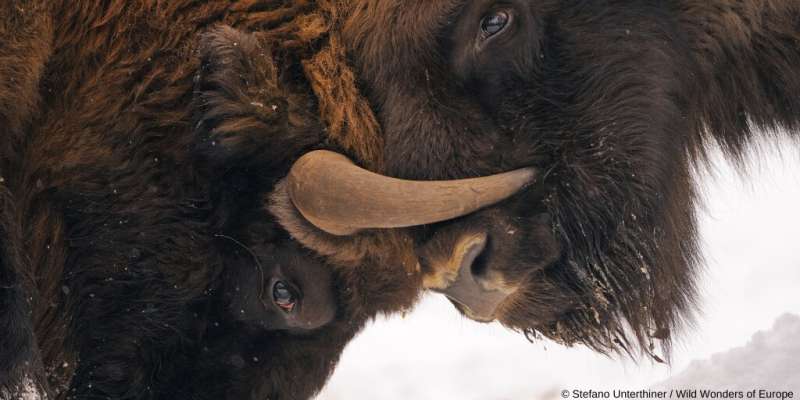Rewilding bison in the Carpathians to preserve wilderness strongholds and migration routes

Nature is significantly degraded across much of Europe, impacted by factors such as infrastructure construction, intensive agriculture and forestry, and the disappearance of naturally occurring, large-bodied animals such as large carnivores and bison. This is the finding of new research published today by a coalition of NGOs and research institutes, consisting of a series of maps and policy papers which provide policy-makers with critical and effective new tools to decide why, where and how to restore nature using rewilding principles. The policy papers demonstrate the urgent need for European politicians to prioritise nature restoration in the upcoming EU Biodiversity Strategy to 2030. Using ecological integrity as a baseline, the tools can help identify EU-level priority areas and corridors that need to be protected and restored to improve the overall coherence and connectivity of the Natura 2000 network.
The highlight of the papers is a series of new maps which, by helping to identify priority areas for landscape-scale nature restoration across the EU, can deliver critical new connectivity between Europe's Natura 2000 sites. Integrating a range of different data sets, the maps can be used in conjunction with local data to inform and guide policy makers as they plan and deliver nature restoration. These maps come at an opportune moment—the European Commission is due to announce its 2030 Biodiversity Strategy by the end of April. 2020.
"The European Commission should propose, in the upcoming 2030 Biodiversity Strategy, new legislation that drives large-scale restoration and ensures the connectivity of ecosystems vital for biodiversity and climate," said Sabien Leemans, Senior Policy Officer for Biodiversity, WWF European Policy Office. "Such legislation must have legally-binding targets to restore ecosystems expressed in square kilometres. Existing policies that undermine nature restoration—such as EU incentives to grow bioenergy crops or harvest forest biomass for energy—need to be revised."
Rewilding bison in the Carpathians will help maintain ecological connectivity and keep ecological corridors open.
The European bison (Bison bonasus) is one of the most threatened large mammals in the world, and it is protected at the European level. WWF Central and Eastern Europe's and Rewilding Europe's Life Bison Project aims to establish a wild bison population that is demographically and genetically viable, by reintroducing individuals in the south-western Carpathian Mountains of Romania, where one of the largest wilderness areas in Europe survives.
Bison bonasus, the largest land mammal in Europe, is a key species for preserving wilderness strongholds. The bison's browsing ability in the search of food helps maintain a mosaic of forested areas and grasslands, a landscape which is highly valuable from for its biodiversity and natural resilience in the face of climate challenges. Moreover, the bison is a species that, if successfully re-introduced and its habitat actively preserved across the entire Carpathian Mountains, will help maintain ecological corridors on a large scale, allowing for species migration, be it the bison itself or other large carnivores such as the brown bear, the wolf or lynx.
The Life Bison Project partners organised two new bison transports in the Armeniș area in 2019, with 11 new bison coming from seven reserves and breeding centres in Germany. The new additions to the herd will help ensure genetic diversity and a better chance for healthy future generations. Reintroducing bison to the landscape after a 200 year absence, just like the sturgeon, is an excellent example of our regional strategies to implement the New Deal for Nature and People. The project can help us achieve the zero-half-zero goals by lessening the impact on natural resources and increasing biodiversity in the Southern Carpathians.
- ZERO loss of natural habitats;
- HALVE the ecological footprint of production and consumption; and
- ZERO human-induced extinction by 2030.
"Romania now has over 100 free roaming bison. Ensuring the continuity and prosperity of this keystone species is essential for the biodiversity of the entire Carpathian range. We are overjoyed to have the support of the local community and to see the success of other similar initiatives across the Carpathian Mountains, in Vânători-Neamț National Park and now also in the Făgăraș Mountains," says Bianca Stefanut, senior communications officer, WWF-Romania.
Ecosystems managed according to rewilding principles, and therefore regulated by natural processes, require zero or few management costs relative to systems dependent on constant human intervention. In many rural areas with increasingly depressed economies, rewilding can create opportunities for new businesses such as ecological restoration, wildlife watching and sustainable use of natural resources. Ecological restoration according to rewilding principles thus provides new opportunities for managing land that is otherwise economically unproductive in a cost-effective way and delivers a suite of ecosystem services with benefits to people and the environment. The local communities embrace and benefit from the bison's return. Ecosystem services gained by the reinvigorated protected areas have led to ecotourism and sustainable development benefiting the local economy. More than 100 families are benefiting from the resulting eco-tourism packages and goods and services based on the presence of the bison for over 300 annual tourists. In fact, the community takes joint responsibility for the safety and well-being of the herd. If the animals happen to get too close to a village, a voluntary intervention group of local hunters formed with the support of the Armeniș local authorities can join the rangers in guiding the bison back into the wild. Bison GPS collars are correlated with a virtual fence which signals via SMS or e-mail to rangers if a bison is approaching too closely to high risk areas such as haystacks, villages and orchards.
Provided by WWF

















